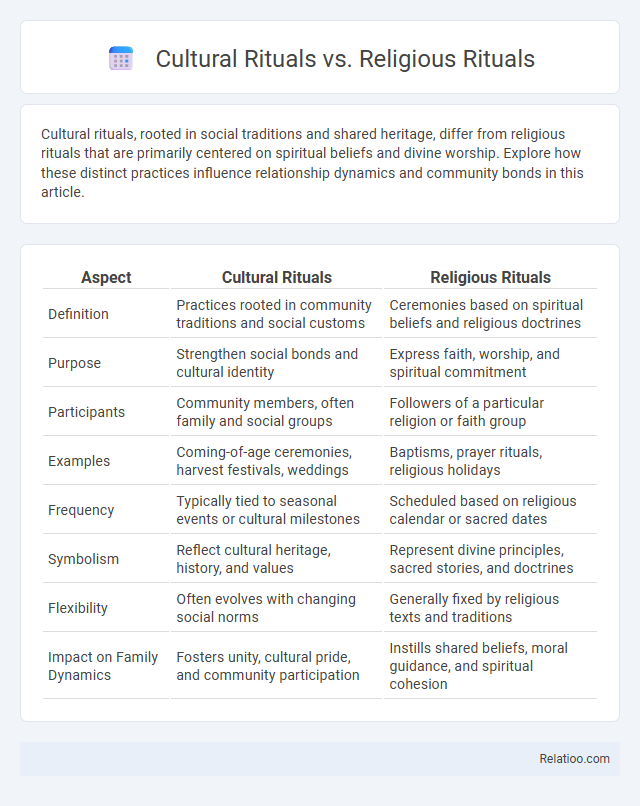Cultural rituals, rooted in social traditions and shared heritage, differ from religious rituals that are primarily centered on spiritual beliefs and divine worship. Explore how these distinct practices influence relationship dynamics and community bonds in this article.
Table of Comparison
| Aspect | Cultural Rituals | Religious Rituals |
|---|---|---|
| Definition | Practices rooted in community traditions and social customs | Ceremonies based on spiritual beliefs and religious doctrines |
| Purpose | Strengthen social bonds and cultural identity | Express faith, worship, and spiritual commitment |
| Participants | Community members, often family and social groups | Followers of a particular religion or faith group |
| Examples | Coming-of-age ceremonies, harvest festivals, weddings | Baptisms, prayer rituals, religious holidays |
| Frequency | Typically tied to seasonal events or cultural milestones | Scheduled based on religious calendar or sacred dates |
| Symbolism | Reflect cultural heritage, history, and values | Represent divine principles, sacred stories, and doctrines |
| Flexibility | Often evolves with changing social norms | Generally fixed by religious texts and traditions |
| Impact on Family Dynamics | Fosters unity, cultural pride, and community participation | Instills shared beliefs, moral guidance, and spiritual cohesion |
Understanding Rituals: Definitions and Distinctions
Understanding rituals involves recognizing their varied forms and purposes; cultural rituals are community-based practices that reinforce social bonds and identity, while religious rituals are sacred ceremonies expressing devotion and spiritual beliefs. Both types of rituals share structured sequences of actions but differ in context and significance, with cultural rituals often linked to tradition and social norms, and religious rituals tied to faith and divine communication. You can deepen your awareness by exploring how rituals, in general, serve as symbolic acts shaping human experience and societal values.
Historical Origins of Cultural and Religious Rituals
Cultural rituals, rooted in the social practices and traditions of specific communities, often date back to prehistoric times and serve to reinforce group identity and social cohesion. Religious rituals, which have ancient origins in spiritual beliefs and divine worship, are documented as early as Mesopotamian and Egyptian civilizations, often designed to communicate with deities or secure supernatural favor. The historical origins of both cultural and religious rituals reveal the fundamental human need to create structured ceremonies that provide meaning, continuity, and connection to a larger cosmological or societal order.
Key Characteristics of Cultural Rituals
Cultural rituals are community practices rooted in shared customs, traditions, and social values that often mark significant life events or seasonal changes. They emphasize collective identity, social cohesion, and continuity without necessarily invoking divine authority, distinguishing them from religious rituals that focus on worship and spiritual beliefs. Understanding your participation in cultural rituals highlights how these ceremonies reinforce societal bonds and preserve heritage.
Core Elements of Religious Rituals
Core elements of religious rituals include sacred symbols, prescribed actions, and a structured sequence designed to connect participants with the divine or spiritual realm. These rituals often involve communal participation, invocation of deities or spiritual forces, and adherence to traditions passed through generations. In contrast, cultural rituals emphasize social norms and collective identity without necessarily invoking spiritual beliefs, while general rituals may lack the sacred context central to religious ceremonies.
Overlapping Spaces: When Culture Meets Religion
Cultural rituals and religious rituals often overlap, creating spaces where traditions and spiritual beliefs intertwine to shape communal identities and personal experiences. Your participation in these rituals reflects shared values and symbolic meanings that transcend individual practices, blending historical customs with sacred observances. Understanding this intersection reveals how rituals serve as dynamic expressions of both cultural heritage and religious faith in everyday life.
Purposes and Meanings: Social vs. Spiritual Functions
Cultural rituals primarily serve social functions by reinforcing community bonds, shared values, and collective identity through traditional practices and ceremonies. Religious rituals emphasize spiritual purposes, facilitating connection with the divine, expressing faith, and fulfilling sacred duties within a religious framework. While cultural rituals focus on societal cohesion and continuity, religious rituals provide spiritual meaning and a sense of transcendence beyond the material world.
Regional Examples of Cultural Rituals
Cultural rituals vary widely across regions, reflecting unique traditions such as Japan's tea ceremony emphasizing harmony and respect, India's Holi festival celebrating color and joy, and Mexico's Day of the Dead honoring ancestors through elaborate altars. While religious rituals typically involve structured worship and sacred practices tied to specific faiths, cultural rituals often represent communal identity and social cohesion without explicit religious connotations. Your understanding of these distinctions enhances appreciation for the diverse ways communities express values, history, and belonging through ritualistic acts.
Prominent Religious Rituals Around the World
Prominent religious rituals around the world, such as the Hindu festival of Diwali, the Islamic practice of Salah, and the Christian ceremony of the Eucharist, play a vital role in the spiritual lives of millions. These rituals often involve prescribed prayers, symbolic acts, and communal participation that reinforce faith and cultural identity. Understanding the distinction between cultural rituals, which are rooted in social traditions, and religious rituals, centered on divine worship, can enrich your appreciation of global customs and spirituality.
Ritual Adaptation in Modern Societies
Ritual adaptation in modern societies reflects the blending and evolution of cultural rituals, religious rituals, and general rituals to meet contemporary values and lifestyles. Your participation in ritual practices often integrates traditional beliefs with modern social contexts, enabling rituals to remain relevant and meaningful. This dynamic transformation enhances community cohesion while respecting individual spirituality and cultural diversity.
Impact of Globalization on Traditional Rituals
Globalization profoundly influences cultural and religious rituals, often blending or altering traditional practices while fostering cross-cultural exchanges and innovations. Your local customs may face challenges as global media and migration introduce new beliefs and behaviors, sometimes leading to the dilution or hybridization of rituals. Understanding how cultural rituals differ from religious rituals emphasizes the adaptability and resilience of rituals in preserving identity amidst global interconnectedness.

Infographic: Cultural Rituals vs Religious Rituals
 relatioo.com
relatioo.com